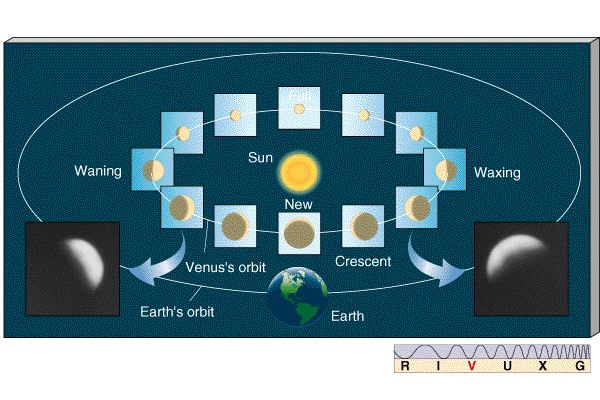

The Venus Transit 2004
... Brief InfoSheet D3
Venus' Orbit and Visibility

The Phases of Venus as it orbits the Sun.
Venus is the second closest planet to the Sun: it orbits the Sun on almost a perfect circle in 225 days and its mean distance is almost three quarters of the distance from the Earth to the Sun.
The orbit of Venus takes it closer to Earth than any other planet, making it very easily seen for us. It is therefore often called the Morning or Evening Star as it is often the brightest object in the sky, with the exception of the Sun and Moon.
The inclination of the orbit of Venus with respect to Earth's orbit is about 3°24', while the interval of time until Venus is again in the same position relative to the Sun, as seen from the Earth, is close to (but not exactly equal to) 584 days. These two properties explain why Venus Transits occur on such rare occasions.
Venus displays phases which are very similar to those of the Moon and were first observed by Galileo. Its apparent size also changes because of the great variation of distance to the Earth: more than a factor 6 !
Venus is quite unusual in that it has a "retrograde" rotation, that is, it turns on its axis in a direction opposite to its motion around the Sun. The planet makes a full rotation in 243 days, but because of this retrograde motion, a solar day lasts 117 terrestrial days on Venus. That would make for a long working day !
On the other hand, Venus' rotational axis is almost perpendicular to its orbital plane - the tilt is almost 8 times smaller than it is for the Earth. Seasonal changes on Venus are therefore rather small: Spring on Venus is not very different from autumn. What's more, the planet's dense, acidic atmosphere produces a runaway greenhouse effect that keeps the surface at 500°C all the year round that's hot enough to melt lead!
Want to know more?
This topic is discussed in a more detailed way in the associated Extended InfoSheet.
Back to the List of Brief InfoSheets.
